- Details
- Written by Gordon Prentice
Background: When Christine Elliott announced she would not be seeking re-election, Doug Ford immediately appointed her office manager, Dawn Gallagher Murphy, to replace her as the official PC candidate in Newmarket-Aurora. The PC riding association was completely excluded from the decision and its President, Bill Hogg, resigned in protest. Gallagher Murphy, who describes Christine Elliott as her friend and mentor, has boycotted all election debates. 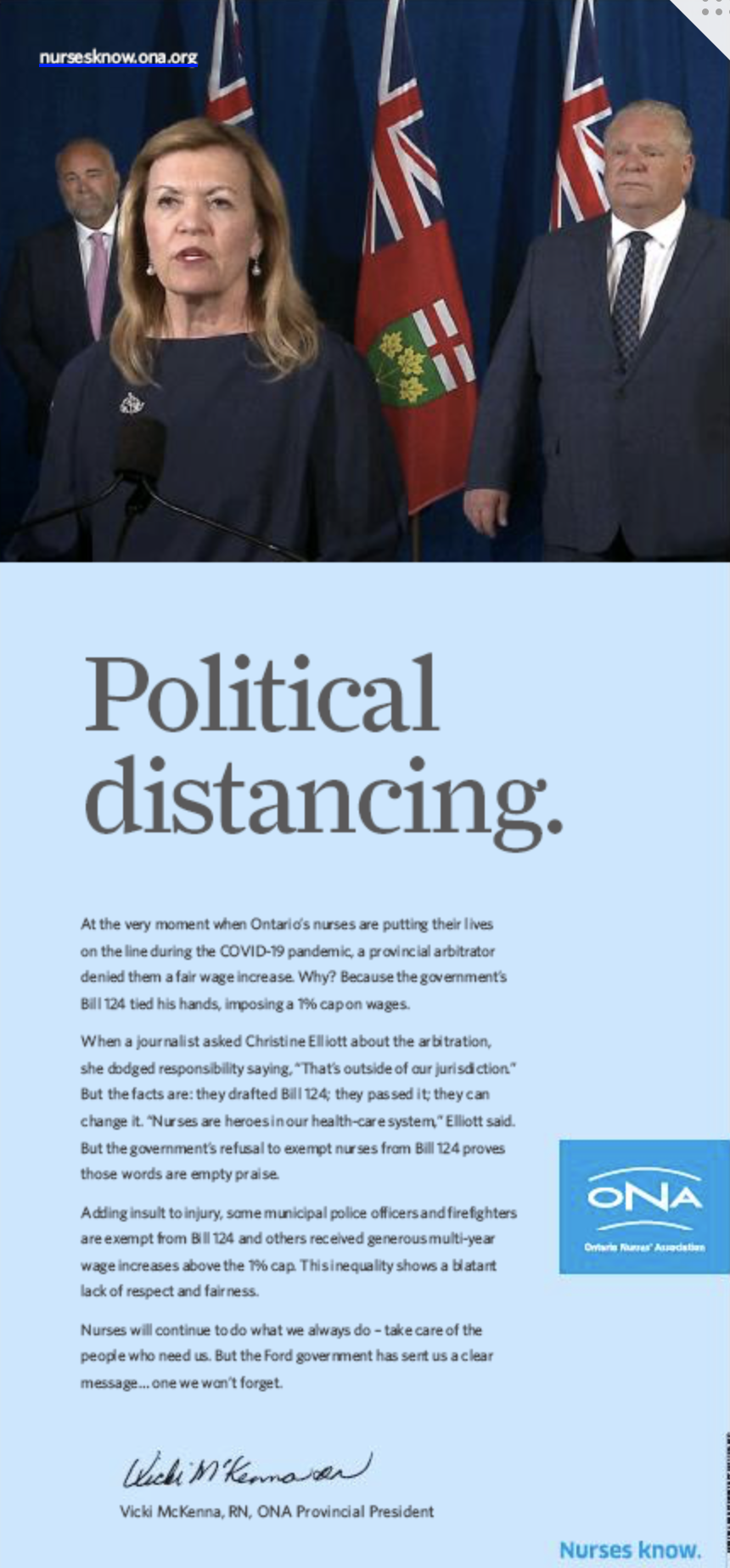
“Number one priority”
Dawn Gallagher Murphy, says Southlake will be her number one priority if, as the polls predict, the office manager becomes our next MPP.
She told Newmarket Today on 11 April 2022 she is passionate about Southlake and
“wants to advocate for the hospital”.
As proof of her commitment she cites the Nature’s Emporium Run for Southlake in 2019. She says she led the team.
Her passion for Southlake is skin deep.
When Southlake nurses asked for a meeting with their MPP, Christine Elliott, they were ignored. Would Dawn Murphy Gallagher MPP meet the nurses if asked? Or would she give them a wide berth?
Cutting nurses' pay the Christine Elliott way
Did Gallagher Murphy agree with Elliott's decision to cap nurses' pay at 1% - falsely blaming the independent adjudicator? (see panel right)
Or does Gallagher Murphy now believe the nurses were short-changed?
And what about the unsafe practices at Southlake? Any qualms?
Was she concerned that Southlake cut the number of nurses during the pandemic as the hospital struggled to balance the books?
To find out what the nurses really feel about Christine Elliott and the PC Government you need only visit the Ontario Nurses Association website.
Southlake got a “one off” cash injection in June last year but the Treasurer, Steve Hills, warned Board members that, despite the extra funding from the Ministry of Health, the hospital would be back in deficit in 2022. Does she have any lingering concerns about the hospital's finances?
Gagging critics
Last year, the Ford Government changed the rules to limit the amount of money that trade unions, charities and other organisations could spend on political advertising in the year before a Provincial general election. Ford relied on the now notorious “notwithstanding clause” to ensure the law could not be challenged in the Courts.
As a result, the amount of money third parties can spend on political advertising during the election campaign itself is severely circumscribed - $4,364 in a single riding and a total spending cap across the entire Province of $109,100. That doesn't buy a lot of airtime.
The law (fortunately) still allows the Ontario Nurses Association and other organisations like it to use their own websites and social media to get the message across.
Planning for new hospitals everywhere
There has been much talk of a new Southlake as if it is just around the corner. Gallagher Murphy celebrates the $5m the Province gave to Southlake to help it work up its plans. This template formula (a few million dollars to work up plans) has been used by the Ford Government in any number of places as “evidence” that new hospitals are on the way.
An announcement on 3 May told us there's $6M to with the planning of Stevenson Memorial Hospital in Simcoe County. On the same day we learn $5M is being earmarked to support planning at Sunnybrook. On 22 April it was the turn of Uxbridge who are getting $2.5M to help their planning. The day before, Waterloo gets $5M to help develop planning.
Before the election there's money for everything.
Until there isn't.
This email address is being protected from spambots. You need JavaScript enabled to view it.

- Details
- Written by Gordon Prentice
The next MPP for Newmarket-Aurora, Office Manager Dawn Gallagher Murphy, says she can't attend the Newmarket Chamber of Commerce election debate on 19 May 2022 because of a "scheduling conflict". 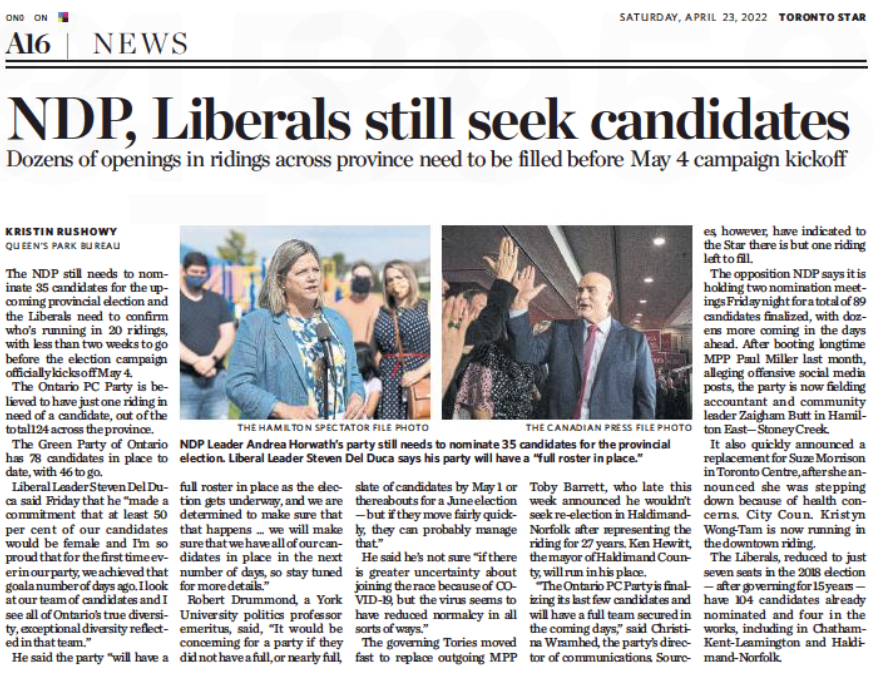
That's pure hokum. What kind of fool does she take us for?
She should clear her diary and be there in person to debate the issues of the day with the other candidates.
That is the right thing to do.
What on earth is she afraid of?
Being found out?
Appointed by Ford as a favour to Elliott
Gallagher Murphy wasn't selected by PC members in Newmarket-Aurora. They were side-lined. She was, instead, appointed by Doug Ford as a favour to his loyal Deputy, the dissembling Christine Elliott.
Selecting candidates for the Provincial Parliament in this way is not OK.
And now we hear of Liberal candidates being dropped by their Party - even in the middle of the election campaign. Here in Newmarket-Aurora, the Provincial Liberal Party dumped Shameela Shakeel for failing to meet the required qualifications for being a Liberal Candidate without giving reasons or elaborating.
The NDP have had their problems too.
All parties shop for candidates for the simple reason they don't grow their own. Our septugenarian MP, Tony Van Bynen, wasn't even a member of the Liberal Party in 2019. He joined so he could throw his hat into the ring. He was the only candidate and is now in Ottawa. (Photo right: on 23 April 2022 parties were still searching for candidates.)
Shell organisations
Astonishingly, a few years ago I was asked by a senior member of a political party here in Newmarket-Aurora if I would consider becoming a Parliamentary candidate. I wasn't even a member of that Party then or now. I laughed at the very suggestion - and said no.
Too many riding associations are shell organizations. And even when aspiring MPs and MPPs sign up armies of new members to secure a nomination, it doesn't necessarily translate into an active riding association. If they join as paper members they generally stay as paper members.
I have no time for this kind of transactional politics which leads to cronyism and clientism.
We need to get more people interested in becoming active members of political parties. But that is a huge ask - especially these days when so many younger people are focussed on single issue campaigns and are cynical about conventional politics.
Wither on the vine
So what happens? Political parties - a core part of a living and functioning democracy - just wither on the vine.
Riding associations should be more than vehicles for winning elections. They should be places where Party members can enjoy lively political debate, regularly holding their MPs and MPPs to account. But in too many places this simply doesn't happen.
The media focus is almost exclusively on the Party leadership and the qualities of individual candidates in the ridings is of secondary importance.
Parroting her Patron
Even someone like Dawn Gallagher Murphy will likely be elected to our Provincial Legislature although she just parrots her patron, Doug Ford, and has nothing original to say for herself.
In the Ontario Legislature her vote will have exactly the same weight as her patron, Doug Ford.
But in reality that counts for nothing.
She owes her place to him and will vote as directed. Every time.
This email address is being protected from spambots. You need JavaScript enabled to view it.
Update at 7pm on 12 May 2022: Dawn Gallagher Murphy is a no-show at tonight's candidates' event hosted by the Aurora Public Library.
- Details
- Written by Gordon Prentice
The PC candidate for Newmarket-Aurora, Dawn Gallagher Murphy, was a no-show at this morning’s “Provincial Election Event 2022” hosted by the Aurora Chamber of Commerce. 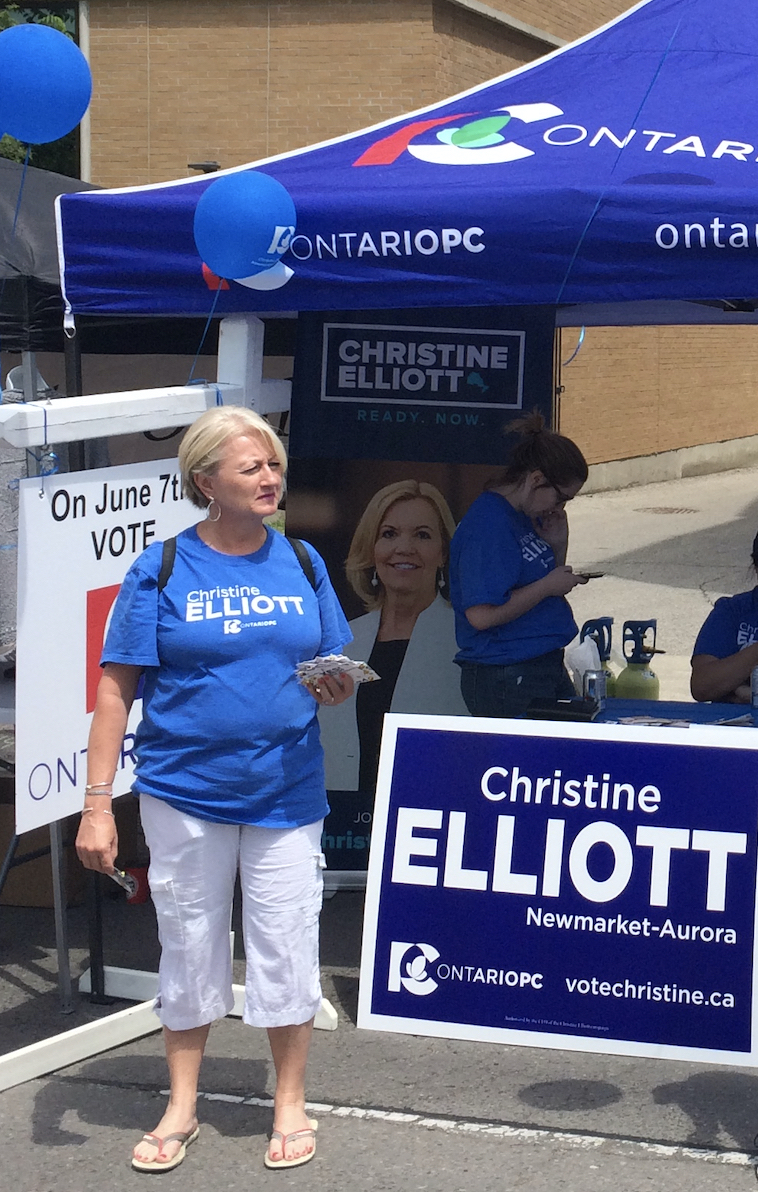
If we are to believe the polls, Dawn, handpicked by Doug Ford, will be our next MPP. So I was naturally disappointed that something kept her away.
I think we should be told what was more important than today’s election event.
Dawn’s A La Card Marketing and Consulting Services Limited which she founded in 2003 is based in Aurora. I don't see her A La Card in the Aurora Chamber of Commerce business directory but I’m sure it’s in there somewhere. She will want to support her local Chamber of Commerce.
Silent and Shadowy
Until now, Christine Elliott’s Office Manager has always been a silent and shadowy figure hovering in the background. But now she craves the limelight. (Photo right: Dawn handing out leaflets in Yonge Street, Aurora, before the 2018 Provincial Election)
I was keen to hear her make the case for the Progressive Conservatives and for Doug Ford, her patron, whom she idolizes.
The NDP’s Denis Heng and the Liberal Party’s Silvain Roy both put in solid performances as did the Green candidate, Carolina Rodriquez, but the format could be made more challenging.
The stiff, wooden, metronomic format doesn't do the candidates any favours.
Spontaneity
These “debates” need a bit more unpredictability and spontaneity if they are to grab the attention of the voting public and keep us all engaged.
The candidates should have the opportunity to quiz each other - with the moderator standing by to keep order.
And they need the front-runner to be there, taking on all-comers and showing us what she's made of.
This email address is being protected from spambots. You need JavaScript enabled to view it.
Update on 12 May 2022: Newmarket Today reports that Dawn Gallagher Murphy has declined to attend the Newmarket Chamber of Commerce election debate on 19 May 2022 due to a "scheduling conflict"
Below: at the 2019 Federal Election candidates' debate held at the St Andrew's Golf Club in Aurora. Green candidate Walter Bauer transfixes the audience, explaining the significance of the Climate Stick, while Dawn tucks into her omelette and bacon.
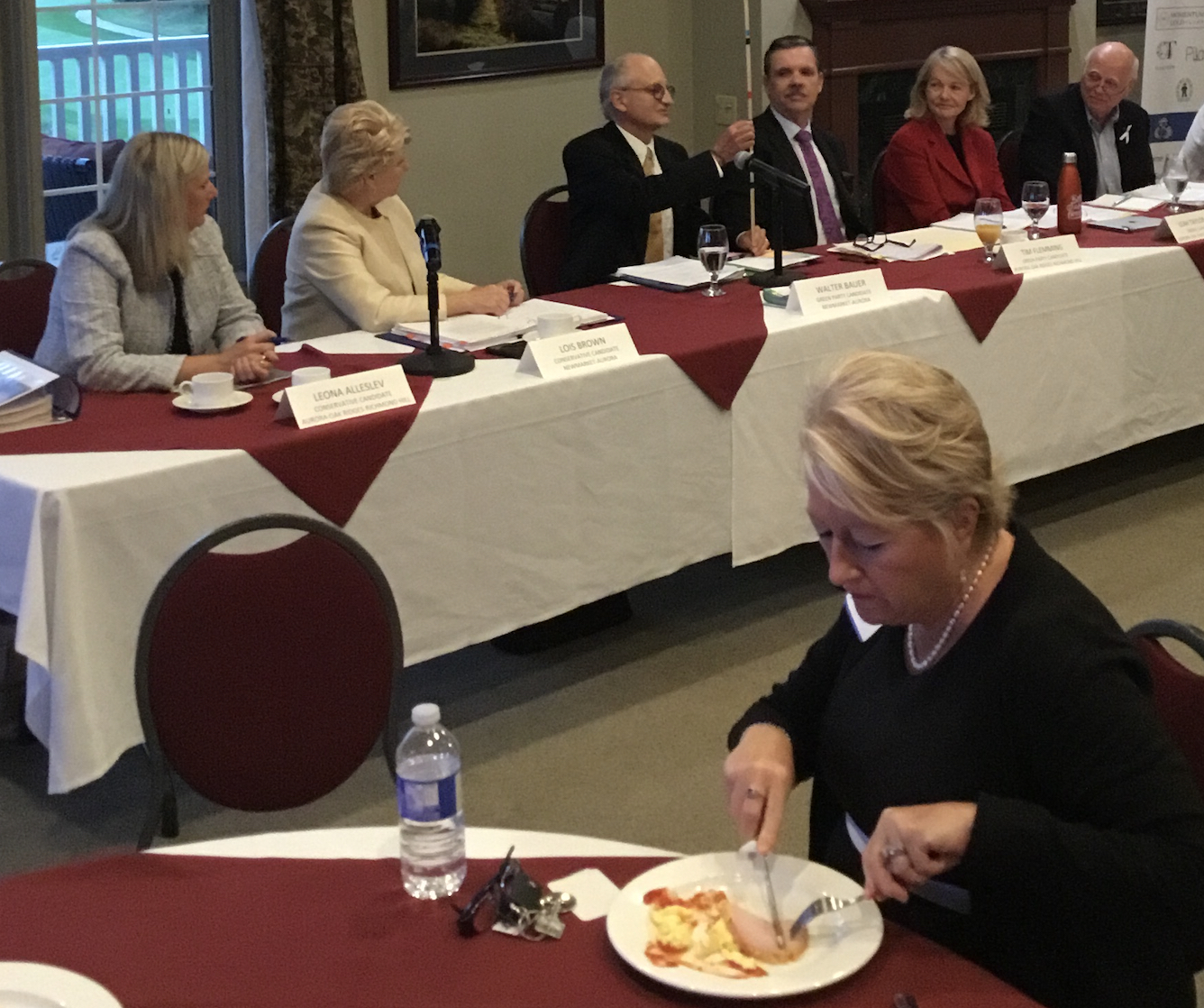
The result last time in 2018. Elections are snapshots in time. In the 2019 and 2021 Federal Elections in Newmarket-Aurora voters returned a Liberal MP.
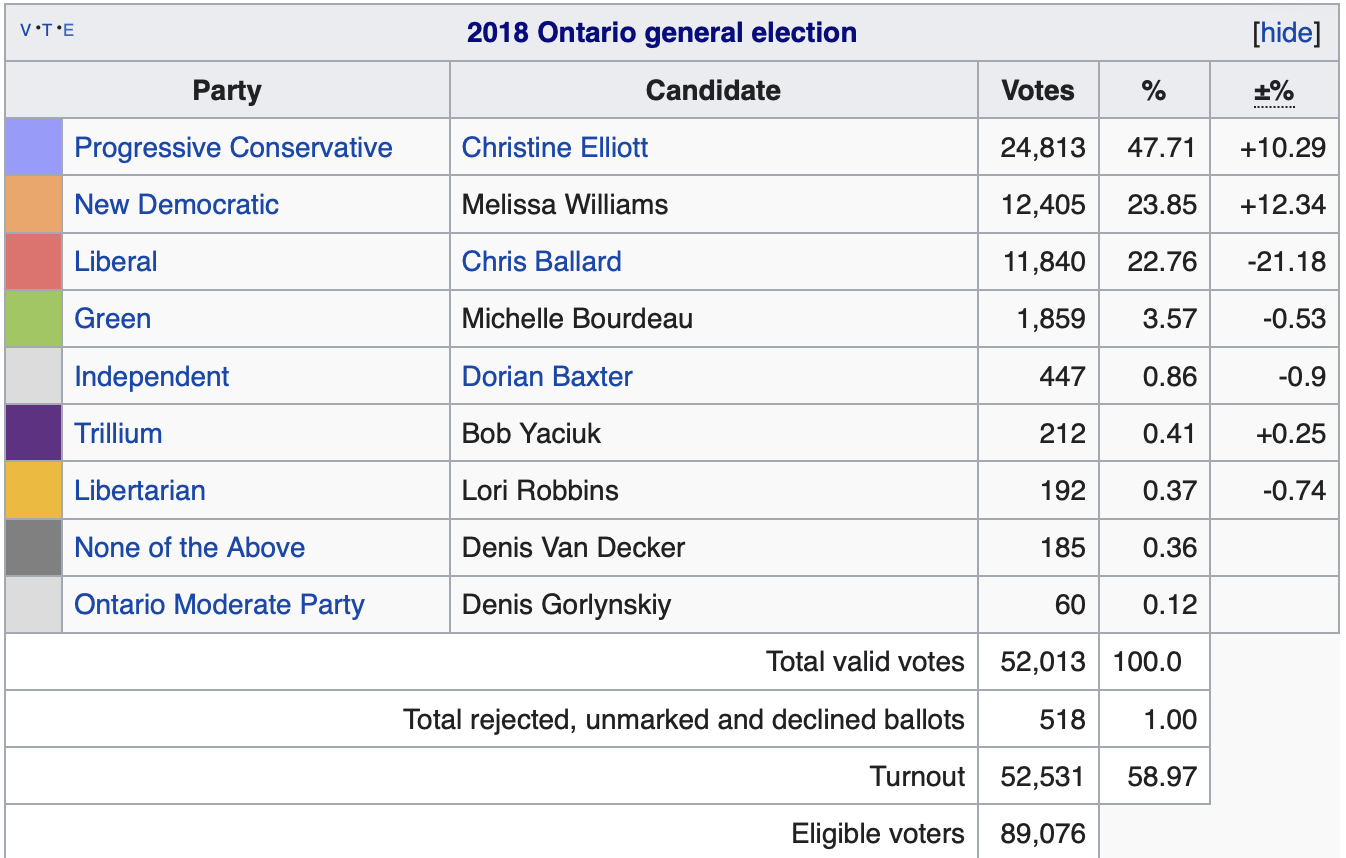
- Details
- Written by Gordon Prentice
If we believe the pollsters it is all over bar the shouting in Newmarket-Aurora. The PCs are home and dry with odds of winning put at 83% - as projected yesterday by the polling aggregator Canada338. 
A new poll from Nanos Research gives the PCs a comfortable seven-point lead at the start of the campaign.
Dawn who?
If we believe this our new MPP will be Dawn Gallagher Murphy, hand-picked by Doug Ford as a thank you to Christine Elliott for services rendered. Dawn is Elliott’s Office Manager but, other than that, we know very little about her.
Of course, a lot can happen during the campaign. In the last Provincial Election in 2018 no-one - let alone the pollsters - predicted the Liberals would be reduced to a rump of 7 MPPs.
No signs of love-in
The aim must be to stop Ford winning an overall majority of seats but that may be a tall order. The love-in between the Federal Liberals and Federal NDP has not been reciprocated by their provincial cousins who continue to bad mouth each other with accusations of broken promises and so on.
All the declared candidates so far are new faces, at least to me. The NDP’s Denis Heng, an epidemiologist, is a member of Aurora’s Community Advisory Committee. The Liberal’s Sylvain Roy is a psychologist backed by former MPP Chris Ballard. The Greens are fielding Carolina Rodriguez, a university student. And, to the right of the PCs, we have the New Blues with Iwona Czarnecka. (Photo right)
Meet and Greet
All the candidates were selected very late in the day giving voters little chance to get to know them. But we shall soon have an opportunity to see the candidates in the flesh and get the measure of them. Do they have thought-through positions on the big issues of the day? Are they persuasive? Can they think on their feet? Are they personable? Do they have a track record? How do they use social media? Can they think for themselves or are they cyphers, mindlessly echoing the Party line on all issues?
The Aurora Chamber of Commerce is hosting a candidates debate on 11 May with the Aurora Public Library holding its own “meet the candidates” event on 12 May. A Kairos event is promised and there is another virtual event organised by the Ontario English Catholic Teachers’ Association on May 17. I shall post details of others as they become known to me.
There will be two leaders’ debates – in North Bay on 10 May and another in the TVO studios on 16 May.
This email address is being protected from spambots. You need JavaScript enabled to view it.
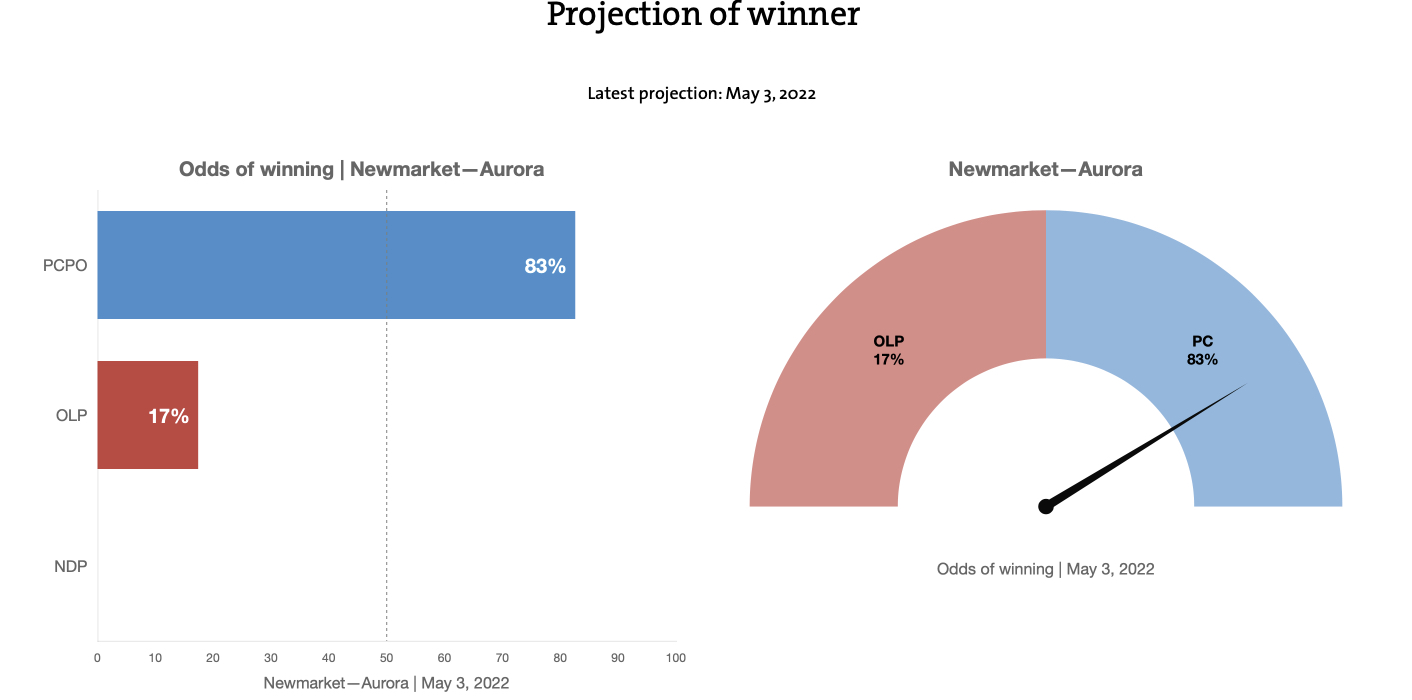
Update on 6 May 2022: Newmarket Chamber of Commerce debate from 6.30pm-9pm on 19 May 2022.
- Details
- Written by Gordon Prentice
On December 14, 2021 the Town of Newmarket gave a tax receipt for $14,290,000 to the developer, Marianneville, in exchange for a "charitable donation" of 16 acres of land at Glenway West. (see plan below). 
The land was professionally valued but the appraisal is a work of pure fiction.
The valuers landed on their Fair Market Value of $14.2M by making (in their own words) an “extraordinary assumption” that the two stormwater ponds in the donated land could be filled in and the land could be used for a townhouse development.
The Town did not challenge or query this but accepted the valuation report and its conclusions at face value when they were – and are - plainly invalid.
Inflated valuation
The tax receipt overstates the value of the land.
The “tax receipt” issue was touched upon by Kathryn Morton, a deputant to the Town’s Committee of the Whole on 31 January 2022. She was assured that the issuing of the tax receipt to the developer came at no cost to the Town, direct or indirect. The Chief Financial Officer, Mike Mayes, explained:
“We issued a tax receipt. Actually it is a donation receipt that can be used for tax purposes. The cost was just basically the cost of printing off the piece of paper.”
That is true. But there is, of course, a cost to the Canada Revenue Agency in the shape of foregone revenues. The tax receipt can be used by the developer to offset tax otherwise owing.
Pond 3 features in two different scenarios:
Scenario "A": Tomorrow, when councillors are considering giving draft approval for Marianneville’s 189 unit development at Glenway West, Pond 3 will be part of the discussion. The stormwater pond which was included in the 16 acre charitable donation to the Town is an integral – though small – part of the infrastructure supporting the new development. Water will discharge from the development into Pond 3.
Scenario "B": On 14 December 2021, the Town gave a Tax Receipt to the same developer for $14,290,000 in exchange for a "charitable donation" of land. The Town did nothing to test the "extraordinary assumptions" of a warped Valuation Report which concluded that Pond 3 and its sister to the West could be filled-in and the land used for a townhouse development.
So, to be clear, Marianneville’s new Glenway West development will discharge water into the same storm water pond that their own Valuation Report (commissioned jointly with the Town) says should be filled-in and developed for townhouses if at some stage the land is not required for public open space.
Discharge into stormwater ponds
The report before councillors says:
“storm flows from the proposed development will discharge to three existing stormwater management ponds”
Two of these ponds are owned by the developer. They will be reconstructed and conveyed to the Town. Pond 3, as we know, lies in the donated land.
No other stormwater ponds in the Glenway East or West developments have been filled in.
Compatibility
The staff report looks at the so-called “Compatibility Interface Plan” which is designed to ensure that new developments for infill and intensification fit in and are
“compatible with the existing physical character of the surrounding neighbourhood”
A stable residential neighbourhood wraps around the donated land on three sides. It is characterised by single detached houses. A townhouse development could not be shoehorned into the eastern two-thirds of the donated land without breaching the principles set out in the Compatibility Interface Plan.
I do not believe for one moment the Town’s Director of Planning or its Director of Engineering would approve a townhouse development sitting on top of two filled-in stormwater ponds.
And I don’t believe the ward councillor, Christina Bisanz, would approve either.
But the Town’s senior management clearly believes the tax receipt comes at no cost to the Town and that's all that matters. If the developer gets undeserved millions through the tax system as the result of an artificially inflated land valuation, then so what?
They will look the other way.
This email address is being protected from spambots. You need JavaScript enabled to view it.
This note added on 3 May 2022: Pond 3 is known as Pond 13 in the Town's Comprehensive Stormwater Management Master Plan (2017). As explained in my earlier post, Pond 13 is a permanent wet pond providing water quantity and quality control. It has a design volume of 9,409 cubic metres. An Olympic size swimming pool holds about 2,500 cubic metres of water. The catchment area of pond 13 is almost 8 acres. Text also updated to make clear that Pond 3 is part of the infrastucture supporting the new development. Ponds 3, of course, lies outside the development itself.

Page 74 of 286